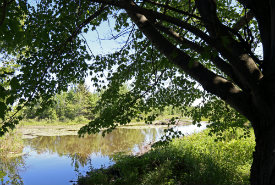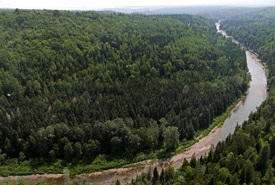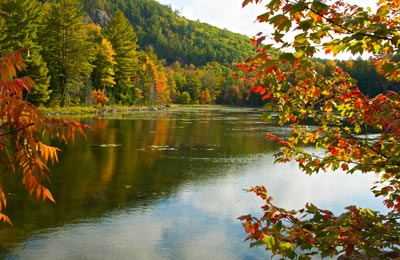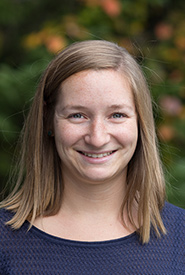A walk in the woods: A homegrown love for the Great Lakes-St. Lawrence forest region

Emma Young Forest by Bill Hubick
I grew up in Cantley, Quebec, in a charming house near a sugar maple forest with a lot of space to play and to explore nature. That area is situated in the southern region of Quebec and is part of the Great Lakes–St. Lawrence forest region. It is known to feature a diversity of species. This forest shelters a mix of coniferous and deciduous trees, comprised of white pine, sugar maple, yellow birch and eastern hemlock, and is home to a diverse range of animals.
Getting to know forests in the Gatineau Valley
My first job as a biologist was in the Gatineau Park, where I explored different ecosystems and monitored many endangered species. One of the most interesting and impressive sights I ever saw was a bald eagle nest in a mature white pine tree. We were able to confirm, for the first time, the nesting of that great bird of prey in Gatineau Park, which is usually only seen during its migration.

Malbaie River property, QC (Photo by Mike Dembeck)
When I’m not working, I spend much of my time canoeing and camping in the Gatineau Valley. What I enjoy the most about these activities is the calm, and the fabulous landscapes that surround you. I also enjoy hiking, especially during winter. A walk in the woods after an ice storm is a magical experience. The trees, covered with ice and bent down because of the weight, make for a spectacular scene that I will never get sick of admiring. Glaze ice, caused by freezing rain, is part of the natural disturbance regime of the deciduous forest. The dynamic and the composition of the hardwood forest is affected by this phenomenon.
Taking young explorers into the forest
I joined the Nature Conservancy of Canada (NCC) this year as a project coordinator for the Southern Laurentian corridor, located east of the Outaouais to the west of the Lanaudière region. I recently had the chance to organize the annual Nature Days event that took place in the Alfred-Kelly Nature Reserve.
Nature Days, launched in 2012 by NCC and HSBC Bank Canada, gives young people the opportunity to discover nature and the diversity of plants and animals around them. Equipped with sketchbooks, the young explorers identified several species of trees and plants while walking along the trail during the botanical activity. The animator took pleasure in sharing with them a number of stories on historical uses for the plants.
During the wildlife activity, they heard many birds, amphibians and insects at several listening spots spread along the trail. The young biologists were given a photo montage of several animals from different groups (mammals, reptiles, amphibians, birds, insects), which they used to note characteristics related to the anatomy, behaviour, distribution, status or habitat of species on the reserve.

Alfred-Kelly Nature Reserve, QC (Photo by Dan Dabbs)
For some of these kids, it was their first time in a wild forest. Situated in the northern limit of the deciduous forest, in an area dominated by sugar maple and yellow birch, this natural reserve is a Laurentian jewel.
Kenauk, another gem in the Great Lakes-St. Lawrence forest region
Most of my projects are based in the Kenauk area, a 64,000-acre (25,900-hectare) private property in which 9,884 acres (4,000 hectares) are owned and protected by NCC. This area is as rich in biodiversity as in history and well worth the conservation effort. The reserve contains more than 60 lakes.
The rhapsody of fall colours through the Kenauk Nature Reserve’s forest valleys is spectacular. As you walk in the forest, you’ll have to share the path with a lot of animals that are also using this important forest as their habitat. NCC shares a vision with many other stakeholders to conserve a network of large, connected tracts of healthy forest to other large protected habitats, which supports healthy populations of the wildlife that depend on it.
Grateful for the forest, and my role in protecting it
As time goes by, I learn more about the Great Lakes-St. Lawrence forest and feel blessed to have the opportunity to frequent it and to work for its protection.


